The post Moffett: Cable will ultimately win in wireless appeared first on Wi-Fi NOW APAC.
]]>By Claus Hetting, Wi-Fi NOW
In the race towards the convergence of networks, cablecos are not only way ahead. They will also ultimately win. This was the key message from award-winning telco financial analyst Craig Moffett, Partner of MoffettNathanson, at this year’s Wi-Fi NOW USA in Washington DC.

Craig Moffett, Partner of MoffettNathanson, speaking at Wi-Fi NOW USA in Washington DC, April 19, 2017.
“Whomever has the densest wired network will win in wireless. That means that cable’s infrastructure will ultimately win, just as it has already won in broadband,” said Craig Moffett at Wi-Fi NOW Washington DC.
The key here is the inevitable densification of wireless networks needed to meet the surge in wireless data demand. As densification happens, the importance of wired infrastructure (to support wireless services) grows, Moffett said.
As a consequence, wireless networks will begin to look and behave as wired networks, and the one thing we know about wired network economics, is that they won’t support many networks, Moffett said. There will be room for fewer telcos and cablecos, and there’s just not going to be room for four. In fact, just saying that T-Mobile & Sprint will merge will not be enough, Moffett said.
Moffett also highlighted what he called the ‘most disruptive part’ of Comcast’s recently launched Xfinity Mobile service: The $12 dollar a month 1 GB plan. The service – which will rely heavily on Comcast’s Xfinity Wi-Fi network for capacity – addresses abut 10% of the US mobile market. But that’s still a lot of subscribers, Moffett said.
Moffett also said that outside of a handful of highly dense areas, it’s unlikely that the economics of 5G will ever make sense. “The US is an extraordinarily non-urban society. Add to that I don’t know what would be the big wireless revenue opportunity,” Moffett said with reference to future 5G. He also said that the idea that autonomous vehicles will drive 5G deployments, is flawed.
/Claus.
The post Moffett: Cable will ultimately win in wireless appeared first on Wi-Fi NOW APAC.
]]>The post EU approves grant program to fund free Wi-Fi appeared first on Wi-Fi NOW APAC.
]]>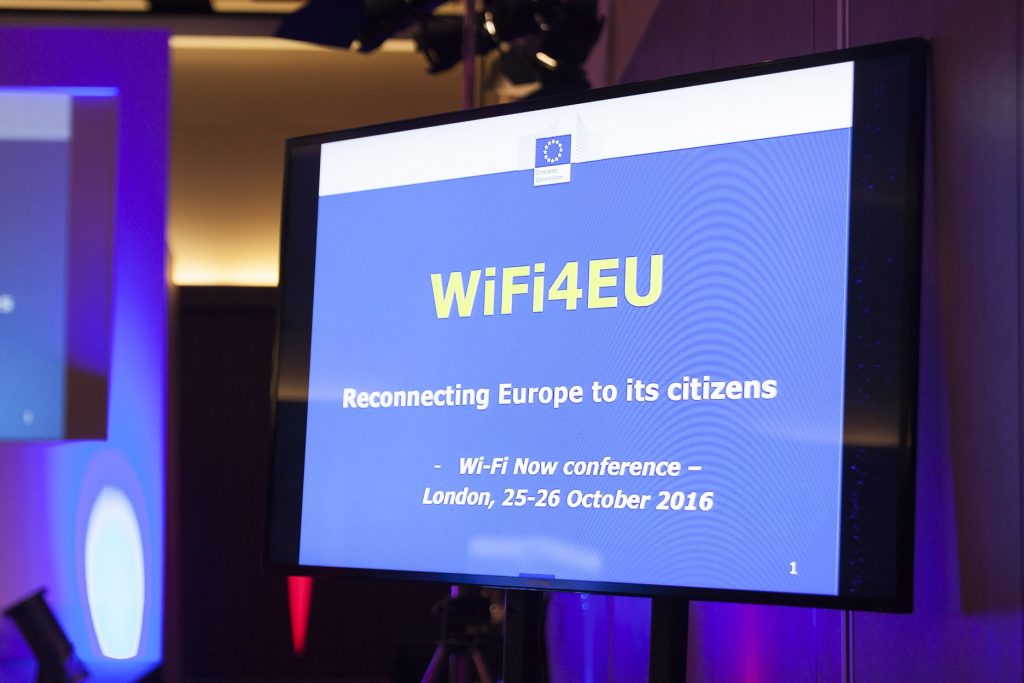
EU approves grant program to fund free Wi-Fi
by Claus Hetting, Wi-Fi NOW
Up to 8,000 communities across Europe can now look forward to free EU-funded Wi-Fi. On Tuesday May 30 the EU Parliament, the Council, and the Commission agreed to spend 120 million EUR on the WiFi4EU project. The European Commission released this statement on the decision.
The project was first announced in September last year by Commission President Jean-Claude Juncker in his 2016 State of the Union address. Since then, the EC has been frugal in releasing more information on the project, although the approach appears unchanged from the original plan: An EU city government or similar with a ‘public mission’ can request a grant that will cover the cost of Wi-Fi equipment and installation up to a value of 15,000 or 20,000 EUR.
Grant by vouchers
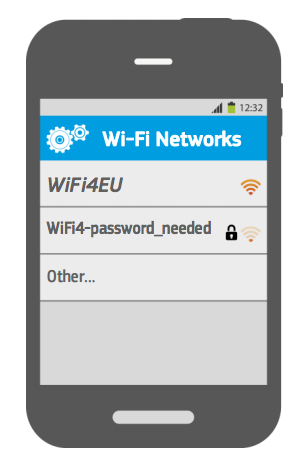 The EC says the first batch of funding will reach 20 million EUR growing to a total of 120 million EUR by the end of 2019. For disbursement, the EC intends to employ a voucher scheme where a local authority is granted a WiFi4EU voucher, which is then used to ‘pay’ the Wi-Fi solution provider for the network. The provider can then cash their vouchers with the EC. The grants will not cover network operational costs.
The EC says the first batch of funding will reach 20 million EUR growing to a total of 120 million EUR by the end of 2019. For disbursement, the EC intends to employ a voucher scheme where a local authority is granted a WiFi4EU voucher, which is then used to ‘pay’ the Wi-Fi solution provider for the network. The provider can then cash their vouchers with the EC. The grants will not cover network operational costs.
Additional conditions state that WiFi4EU networks will only be built where a ‘similar public or private offer does not yet exist’, the factsheet says. Presumably, a ‘similar offer’ in this case refers to free private or public Wi-Fi networks and not mobile services, although this is not explicitly stated by the EC. The EC intends to kick off the first round of grants ‘as soon as the WiFi4EU scheme is approved’ – which is now, at least in theory.
But will the scheme work?
That – of course – is the 120 million EUR question. The EC has already been criticised for not allocating enough funds per network build. But given that Wi-Fi networks can be built for what amounts to spare change compared to their mobile brethren, 20,000 EUR will go a long way towards building small but useful Wi-Fi networks for example for libraries, health centres, or similar public venues. Wi-Fi NOW estimates that about 15-20 indoor Wi-Fi APs can be purchased and installed for a grant value of 20,000 EUR. For outdoor installations, the number of APs per grant is probably half of that.
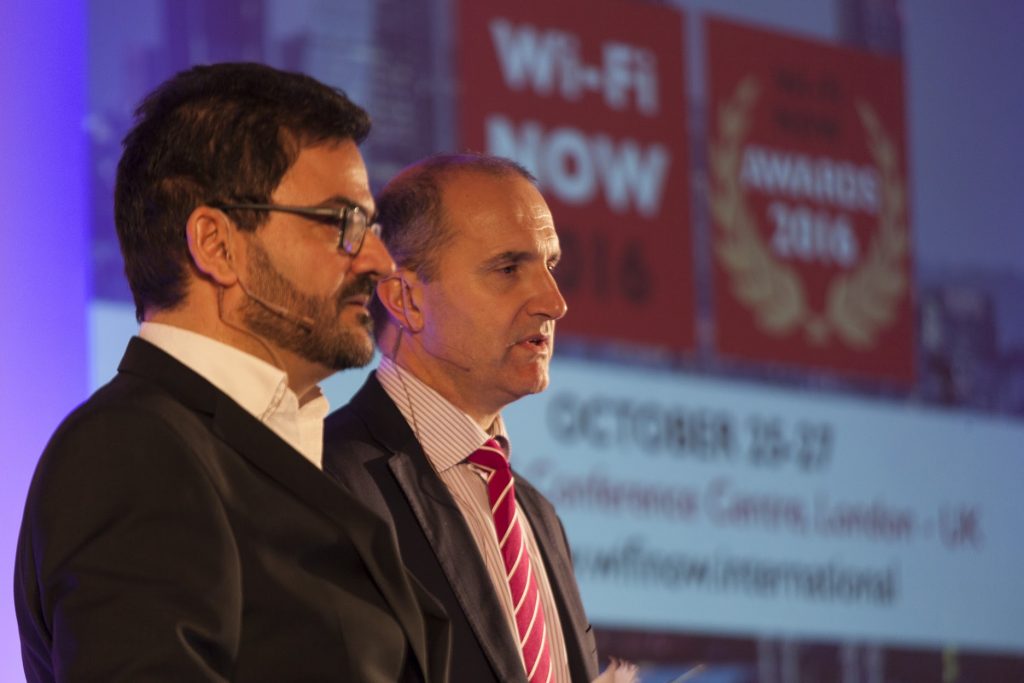
The EC’s Deputy Head of Unit in charge of WiFi4EU Hervé Dupuy (right) and Wi-Fi NOW Chairman Claus Hetting (left) on stage at Wi-Fi NOW London, October 2016.
The EC’s ambitious connectivity goal
So if the EC is successful in finding takers and if 8,000 such networks are eventually built, the end result could be a whopping 120,000 Wi-Fi APs serving millions of users with free Wi-Fi across the EU. The EC cites a goal of 40-50 million connections per day, or more than 6,000 connections per day per WiFi4EU network. That’s a fairly ambitious goal. On the other hand, free Wi-Fi in the right underserved locations will no doubt attract a lot of users. After all, free is the ultimate unbeatable price.
Add to that that the EC is likely to set a minimum speed requirement of perhaps as much as 30 Mbps for the service, sources say. Speeds like that should attract users in droves. If all of this pans out as planned by the EC, WiFi4EU will be a big boost not only to public connectivity but also to the growth of the Wi-Fi ecosystem in Europe.
Local authorities building the networks will need to pay for operational costs. In most cases (since well-built Wi-Fi networks are largely maintenance free) this will amount paying for the backhaul (ISP) connection for the service and likely not much more. It’s still not clear how WiFi4EU networks will facilitate EU-wide WiFi4EU roaming and what operational costs this may introduce for network owners.
/Claus.
The post EU approves grant program to fund free Wi-Fi appeared first on Wi-Fi NOW APAC.
]]>The post WiGig is more than just connectivity. It’s a platform. appeared first on Wi-Fi NOW APAC.
]]>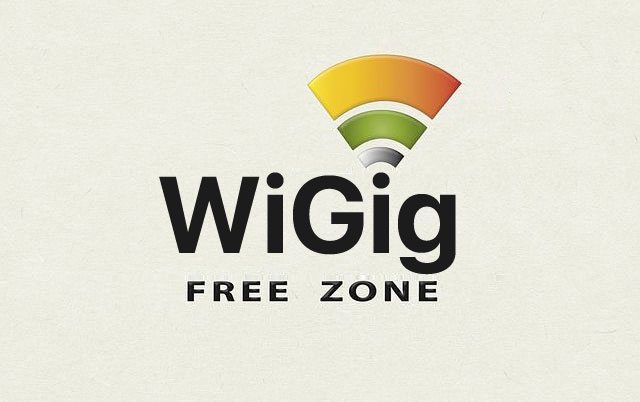
WiGig is more than just connectivity. It’s a platform.
Apple has long been rumoured to be working on an iPhone that includes WiGig. But what exactly is it and how will it change the way we connect?
It’s been years underway: The Wi-Fi standard that’s twice as fast as gigabit Ethernet and more than five times faster than current 802.11ac. It’s called WiGig, and the certification program was launched by the Wi-Fi Alliance in October of last year. But what can we expect from this brand new kind of Wi-Fi and what could new use cases look like?
Wide, clean GHz channels means speed – and lots of it
WiGig works in the unlicensed 60 GHz band (in the US this is 57-71 GHz, in Europe 57-66 GHz), slicing it into 2.16 GHz channels. In comparison, 802.11ac channels start at 20 MHz with options for channel bonding up to 160 MHz-wide channels. That’s less than a tenth of the channel width of just one WiGig channel. For the time being, unlicensed WiGig spectrum is plentiful and nearly entirely unused.
So we will for sure get plenty of speed. Peraso – one of only a handful of WiGig chipset vendors – says up to 8 Gbps is achievable. A WiGig in-home router from TP-Link launched last year boasts top speed of 4.6 Gbps.
WiGig: A platform for innovation
But like everything else that the Wi-Fi industry puts out there, WiGig is much more than just another wireless access standard. It’s a platform for a litany of new use cases and new applications. That likely will include innovations in tech and business models that we can hardly imagine today.
WiGig supports direct mode (essentially wireless replacement for cabling) as well as an infrastructure (network) mode for the home, enterprises, and service providers. And here is a critical point: WiGig will shift dynamically to and from common Wi-Fi in the 2.4 and 5 GHz bands (802.11n and 802.11ac) as part of a triband connectivity network. This is a critical feature as WiGig coverage – even inside the home – is bound to be spotty.
Zero-lag gaming, sync in seconds, and sci-fi style AR
We can only imagine what blazingly fast, zero-lag WiGig might do for gamers, VR, & AR in the home and elsewhere indoors, including finally getting rid of all that messy cabling around the house or office. Or consider syncing your smartphone and backup it up in seconds.
While indoor direct-mode (and short-range) WiGig is likely to be the fist major application to hit the markets, WiGig-enabled triband networks hold tremendous promise for the enterprise and even for connectivity in public spaces.
Imaging how a few seconds of walking past a LinkNYC WiGig-enabled kiosk in New York could download a entire movie to your iPhone or let you scan the neighbourhood with sci-fi-style AR. If you’re sitting on a city bus, you could even sync your tablet to the Cloud before the bus pulls away from the bus stop.
WiGig coverage will undeniably spotty. But speed may well compensate for the lack of mobility, as will dynamic switchover to regular Wi-Fi.
Radios, point-to-multipoint, & mesh
On the infrastructure side, WiGig use cases broadly categorize into point-to-point, point-to-multipoint, WiGig-to-the-home (instead of fibre), and mesh. Ranges for mesh-type units will mostly be limited to a few hundred feet, but vendor IgniteNet is already selling 60 GHz point-to-point product serving up link distances of up to 2.5 km for less than $500.
Meanwhile, Siklu has deployed some 45,000 of their radio units in the 60 GHz and 70/80 GHz bands, and just this year launched a point-to-multipoint 60 GHz system. These are not exactly WiGig standards-based systems, but the quickly growing Siklu footprint says something about what could be in store for the 60 GHz band.
So is WiGig the same as 5G?
Technically it’s not, although the term ‘5G’ seems to have lost most of its original meaning these days. What we can say is that WiGig will support a lot of the same applications that today are being touted as the domain of 3GPP-based (mobile) 5G. And of course – like anything in Wi-Fi – it does this at a fraction of the cost using free, unlicensed bands and low-cost chipsets.
WiGig is also way ahead of any 3GPP-standardised 5G because it’s here today.
/Claus.
The WiGig briefing presented here is sourced from (among others) Peraso Technologies presentation at Wi-Fi NOW Washington DC on April 19, 2017. Below: ABI Research forecast for WiGig chipsets towards 2021.
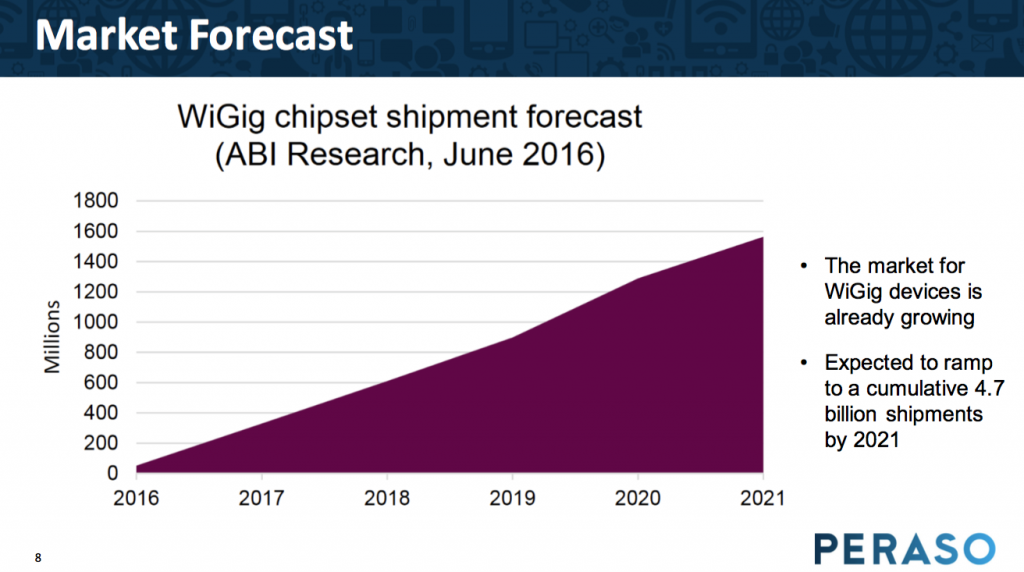
The post WiGig is more than just connectivity. It’s a platform. appeared first on Wi-Fi NOW APAC.
]]>The post AI-Powered Wi-Fi-as-a-Service: Part of a $59.8 billion market by 2025 appeared first on Wi-Fi NOW APAC.
]]>
AI-Powered Wi-Fi-as-a-Service: Part of a $59.8 billion market by 2025
Guest blog by Ronny Haraldsvik, SVP/CMO KodaCloud
The market intelligence firm Tractica forecasts that the revenue generated from the direct and indirect application of AI software will grow from $1.4 billion in 2016 to $59.8 billion by 2025. Key industries for AI adoption will include automotive, business services, investment, media and entertainment, and legal.
“Artificial intelligence has applications and use cases in almost every industry vertical, and is considered the next big technological shift, similar to past shifts like the industrial revolution, the computer age, and the smartphone revolution,” says research director Aditya Kaul.
The need to outsource enterprise Wi-Fi
Wi-Fi as Network as a Service (NaaS) is starting to establish beachhead in companies with 500 or fewer employees, and could grow to become a multi-billion dollar market in the coming years. It starts with Wi-Fi, then on-demand and employee-based monthly software services will follow (firewall, compliance, UC, presence and more). Why you may ask? Recent research by iGR found that 64% of enterprises are more than willing to outsource Wi-Fi because they want to focus on the core business. The reason is very simple! There’s a scarcity of IT expertise to manage networks in one or more locations.
As Harrison Lewis, CIO with Northgate Markets puts it, “Wi-Fi service enables us to focus on our core competency which is to manage stores and distribute food and goods. With this service, we can easily monitor our many stores, distribution center and our corporate office, as one global network from anywhere, and respond when KodaCloud alerts us to any issues which require human intervention.”
Wi-Fi-as-a-Service: From CAPEX to OPEX
Wi-Fi-as-a-Service, powered by Artificial Intelligence and Machine Learning, enables MSP and Enterprise IT departments to provide highly optimised Wi-Fi service to end users in numerous locations, with little or no on-site IT resources required. KodaCloud and other emerging Wi-Fi companies understand that the subscription economy will take over the enterprise in the move from 80% Capex to 80% OPEX.
Wi-Fi-as-a-Service is changing how Wi-Fi networks are deployed and managed. The service includes a network of indoor and outdoor Wi-Fi Access Points (AP) that are shipped directly to customer location(s), eliminating the need for a customer to buy equipment, or a partner to manage inventory or shipments. The entire network can be installed in minutes — all managed for a low monthly fee. With proactive network monitoring, Wi-Fi as a Service identifies and corrects tens of thousands of daily connectivity or performance issues, and can make 80 percent corrections and issue network alerts to IT teams where human intervention is needed.
“With our many distributed office locations, we needed a Wi-Fi network that could run and fix itself, as well as scale with our growing needs. Wi-Fi as-a-service has re-defined how we deploy and manage our Wi-Fi networks – allowing us to focus more on scaling our business.” Michael Ramsey, vice president of information technology with EmployBridge
Time to catch the AI-train?
Though small and medium enterprise customers are the first to benefit from Wi-Fi as a Service powered by AI – larger enterprises and service providers are now taking notice. If scale is not an issue with cloud and AI, then why not embrace a more flexible and OPEX-friendly model?
But, the vendors in the $12 Billion Wi-Fi equipment market will not stand by idly and let the as-a-service companies erode away high-profit margin equipment sales. Incumbent vendors will continue to make announcements about “Cloud Wi-Fi”, enticing customers to buy and manage Wi-Fi the old fashioned way.
AI has influenced cloud access and network services forever, automating what large IT teams, massive infrastructure products and software normally handle. As a result, more and more investments are flowing into Machine Learning and AI startups.
As the saying goes, “the train has left the station” for AI-powered Wi-Fi. Get on, or get left behind. Some large vendors are starting to embrace the new model and 2017-2018 will see a changing landscape between old and new service vendors.
 About the author: Ronny Haraldsvik has 26+ years of experience working with companies in mobile, cloud, wireless, broadband networks, & IP services. Today, Ronny is SVP/CMO for the Wi-Fi startup KodaCloud. You can contact Ronny here.
About the author: Ronny Haraldsvik has 26+ years of experience working with companies in mobile, cloud, wireless, broadband networks, & IP services. Today, Ronny is SVP/CMO for the Wi-Fi startup KodaCloud. You can contact Ronny here.
The post AI-Powered Wi-Fi-as-a-Service: Part of a $59.8 billion market by 2025 appeared first on Wi-Fi NOW APAC.
]]>The post Wi-Fi share of US mobile traffic continues to rise appeared first on Wi-Fi NOW APAC.
]]>Despite the advent of ‘unlimited’ mobile data plans, Wi-Fi’s share of phone data traffic in the US continues to rise. We’ve tracked this with a little help from Fierce, P3, and Spectrum Analytics.
In late January of this year we posted the Q4 2016 Wi-Fi share of phone data traffic for the US (see all the numbers & our analysis in this blog):
AT&T = 71%, TMo = 67%, Verizon = 69%, Sprint = 60%
Here’s the Q1 2107 data for from P3 & Strategy Analytics (see the report from FierceWireless):
AT&T = 72%, TMo = 71%, Verizon = 72%, Sprint = 67%
Thus the rise in Wi-Fi share of traffic is from 1 to 7 percentage points and – importantly – applies to all the US mobile carriers. Sprint is the outlier in this case with a jump of 7% in the course of just one quarter. Here’s the original 1Q 2017 data from P3:
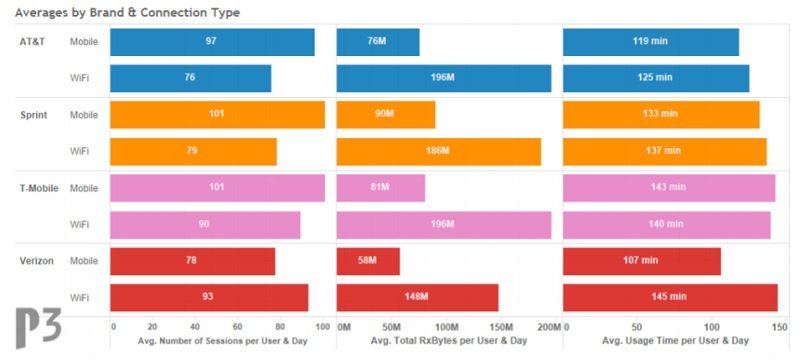
So what does this mean?
First of all, the so-called ‘unlimited’ US mobile data plans have not stopped Wi-Fi’s share of phone traffic from growing. We’re guessing that the numbers would probably have been higher without unlimited plans, but this is conjecture. The data also shows that app-based time on Wi-Fi continues to rise and overall is more than 50% of total time spent accessing apps on phones.
Another notable fact – that nobody else seems to have commented on so far – is that the average mobile traffic per user per day has decreased from 4Q 2016 to 1Q 2017, in Verizon’s case from 76 MB to 58 MB. For the other carriers the drop in cellular data traffic is similar at least according to P3’s and Strategy Analytics’ data.
All of this once again puts to shame the frankly bizarre and misreported story that the death of Wi-Fi is imminent given unlimited plans and the beginning of LTE-U deployments. We’ve commented on it at length here.
Cellular decline continues. Wi-Fi on track for more growth.
US cellular market leader Verizon had a disappointing 1Q 2017 with a more than 7% revenue decline compared to last year. Meanwhile, mobile infrastructure leader Ericsson took another hit with an 11% decline in sales in the same quarter.
It would probably be stretching it to say that ‘offload’ to Wi-Fi is the cause of all this, but certainly the ubiquity of Wi-Fi (especially in the US) has poked a big hole in cellular traffic & profitability over the past couple of years. And there’s no sign that this is slowing down.
/Claus.
The post Wi-Fi share of US mobile traffic continues to rise appeared first on Wi-Fi NOW APAC.
]]>The post Service Provider battle for Wi-Fi footprint heats up appeared first on Wi-Fi NOW APAC.
]]>
Service Provider battle for Wi-Fi footprint heats up
By guest blogger Mark Cowtan, Wireless Marketing Consultant
Service Providers are betting on IoT for growth. However without control of the device footprint at the premises they will be relegated to just the broadband connection, and we know there’s no upside in that.
In my previous article, I spoke about vendor repositioning and acquisitions in the enterprise Wi-Fi eco-system aimed at addressing the underserved SMB market. In the Carrier Wi-Fi space, similar dynamics are at play. This time the fight is over the Wi-Fi footprint in homes and small businesses – the bedrock of any Service Providers’ business. The battle has suddenly escalated, and broadband Service Providers know they need to win it, for any chance of monetizing Wi-Fi services or enabling new services around IoT, in future.
Competition for Subscriber Footprint Intensifies
Every premises will have broadband, Wi-Fi and some kind of IoT devices. Whoever controls the footprint, stands to control the monetization of services. New competition for control of that footprint is coming from three sides: IoT devices and gadgets, cloud Wi-Fi solutions and whole-home Wi-Fi.
The vendors of IoT-enabled appliances, devices and gadgets are penetrating both business and consumer markets with solutions from building automation and security to smart lighting; Traditional WLAN vendors and MSPs are now going after small business with plug-and-play cloud-managed Wi-Fi, and third, a whole-home Wi-Fi invasion from old and new Wi-Fi Mesh players is threatening the home, and this will inevitably spill-over to small business as well.
With the right integrations, each one of these contenders has the potential to become the center of the universe for Management and Analytics from the user’s perspective. The cloud management UI provided to users could become the conduit for other services. Service Providers have an opportunity to take a controlling position with dashboards that unify the management and analytics of all subordinate devices, provided the core Wi-Fi infrastructure is theirs and IoT gateway functionality exists in the CPE (see the analysis graphic here).
Consumers want more control of their Wi-Fi: Passwords, parental controls, guest access, stats etc. and the first to give to them in the right dashboard, has a good chance of retaining control of the footprint. Comcast’s xFi Wi-Fi management interface shows where this is headed. This a good start, but its only scratching the surface of features that could eventually be organized into free and premium management packages.
Stuck With Two Wi-Fi Solutions for Two Markets
Playing in two distinct markets has meant Service Providers need two completely separate Wi-Fi solutions – One for business and the other for consumers. And if Service Providers have Wi-Fi integrated in their small cell network, this might be a third barely managed Wi-Fi network to contend with.
For consumer deployments, cost is everything. Broadband gateways must consolidate as much functionality as possible. Nowadays, a typical consumer CPE may be a 4 port switch, a router, a dual band Wi-Fi AP, and act as a VoIP terminal or Femtocell all at the same time. But Wi-Fi features on such broadband CPEs are generally pretty basic – these devices were never designed to be the anchor of a coordinated home Wi-Fi network, and therefore lack many features including advanced security and management. They could be though. They have the horsepower, right now they are just missing the software!
But now, with growing consumer demand for Wi-Fi in every room, networking requirements once unique to business are crossing over to consumer products. This puts Service Providers at a cross roads. Now is the time to step up to the next generation of managed Wi-Fi that can meet all of their needs.
The race for a Unified Wi-Fi / IoT Solution is on!
How can Service Providers address whole-home Wi-Fi as part of an integrated solution, and not lose it to the invaders, when the two or more Wi-Fi solutions they already have are designed for different needs are not unified in any way? The answer may be found by considering the implications of AT&Ts recent White-box switching trial, and the proposed acquisition of Ruckus by ARRIS.
What AT&T has recently demonstrated by testing white-box switching in its network, is already happening in its own way in Wi-Fi. Since around 2008, numerous ODMs have been manufacturing white-label APs, based on Broadcom or Qualcomm reference designs. To keep R&D costs down, several enterprise WLAN vendors use those hardware designs as is (generally for lower-end models), and simply port their software to them.
Comcast is trying to push equipment vendors in that direction as well, with its RDK initiative. There is no doubt Service Providers want more control of the software to enable features uniformly across multiple generations of devices from different vendors. For Carrier Wi-Fi, the need is more acute than most.
Service Providers could potentially port their own custom version of AP software to both CPEs and ODM access points, and serve all their markets with one unified solution at a much lower price point. That’s what Comcast, BT and others are doing and they are killing it on Wi-Fi monetization, the latest Comcast Mobile announcement is proof pudding of the value of cohesive Wi-Fi infrastructure. I expect they’ll oversell the airtime on those APs, 10 times before we know it.
Since neither WLAN equipment vendors nor Broadband CPE makers have filled this gap, several embedded systems companies who specialise in Wi-Fi, have. Just as Cloud Wi-Fi software vendors have made consumer APs fit for MSPs, Embedded software companies like embedUR have their own AP software, cloud management and service assurance software designed specifically for large-scale Carrier Wi-Fi deployment. The AP software and service assurance agent can be ported to literally any Wi-Fi enabled CPE platform and generic APs.
How does Ruckus play into this?
Cisco, Ruckus and Huawei have dominated the business-end of service provider Wi-Fi. Meanwhile, ARRIS has been a significant channel for Ruckus for many years – reselling the whole solution to its service provider customers for use in business deployments.
ARRIS’s backing, and the bonus of a switching product line from Brocade, now makes Ruckus a much “safer bet” for Service Providers. This reduced sales friction should lead to Carrier Wi-Fi market share gains. ARRIS can also make a more aggressive play in small cells where Wi-Fi is increasingly an essential component. But the real game-changer could come from leveraging Ruckus Cloud management and AP software across the line up of Wi-Fi enabled CPEs. This would ensure their residential gateways become the hub of whole-home Wi-Fi, with sophisticated analytics and service assurance to Service Providers and a dashboard for users. This could provide a foothold for IoT gateway functionality upgrades, next.
Service Providers have much to gain from moving to a single Wi-Fi solution that provides decent management and analytics, and automated service assurance, and ARRIS could deliver this. With Ruckus’ cloud management, and the Xclaim product line, Ruckus is already half-way there. Whether their cloud management can scale to consumer volumes is yet to be seen. In news about the Ruckus acquisition, ARRIS CEO Bruce McClelland said “The next five years will see exciting changes as every service provider will become a wireless operator of some fashion”. He’s right about that, and those saddled with multiple Wi-Fi solutions they cannot manage uniformly, will be at a distinct disadvantage.
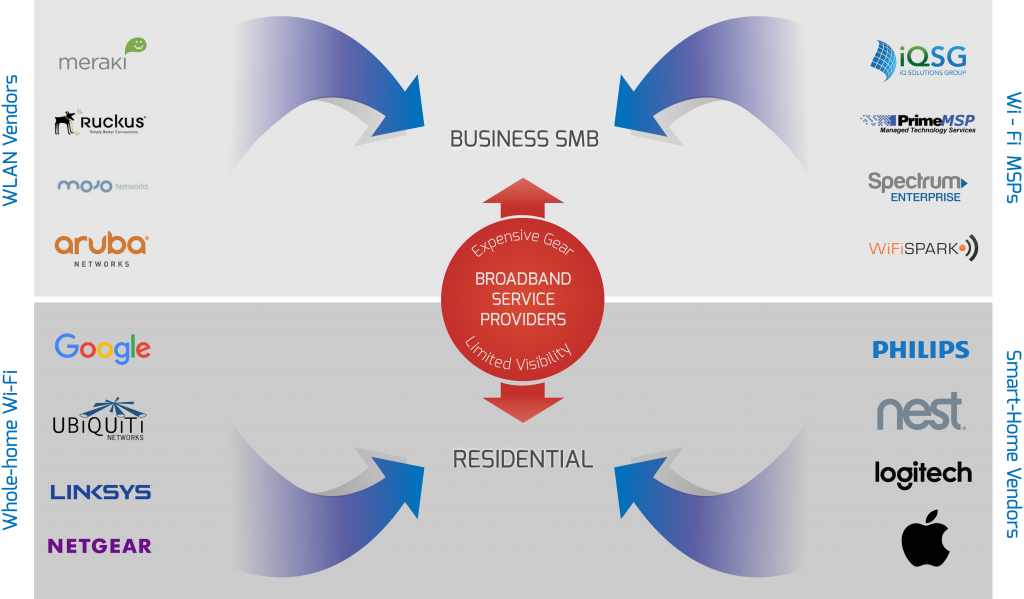
About embedUR systems:
This article is sponsored by embedUR systems – an embedded software company that specializes in Wi-Fi, Access and IoT. For more than a decade embedUR has provided embedded systems support to some the world’s largest network and telecom equipment vendors. embedUR also has a Universal Carrier Wi-Fi platform and automated Wi-Fi Service Assurance which it licenses to Service Providers.
About Mark Cowtan:

Mark Cowtan is a marketing consultant who specializes in Wireless and IoT technology marketing. With 25 years of experience in the Silicon Valley networking industry at numerous startups, and networking giants including 3Com, Nortel and Juniper. Mark’s favorite pastime is helping technology startups bootstrap their marketing and get to market fast.
The post Service Provider battle for Wi-Fi footprint heats up appeared first on Wi-Fi NOW APAC.
]]>The post Second Hall of Fame Inductee appeared first on Wi-Fi NOW APAC.
]]>The reason for the Wi-Fi NOW Hall of Fame is that we have a debt of gratitude towards individuals who have made exceptional contributions to the Wi-Fi industry. We want to honor them, and we’ll be doing it not only at this event but also at future Wi-Fi NOW events.
Our second member of the Wi-Fi NOW Hall of Fame was previously CTO of 2Wire where he was instrumental in introducing Wi-Fi home gateways to the industry, which is now the defacto way people access Wi-Fi from their ISPs. He also pioneered delivering IP services to the home over Fiber and xDSL. He created “Zero Touch” self-installation, bringing DSL to the mass market and authored Broadband Forum TR-124 Broadband Residential Gateway functional requirements, standardizing how service gateways are deployed globally today.
He was also a key figure in driving the wildly successful Broadband Forum TR-069 management standard used throughout the broadband industry on over 350 million devices, streamlining broadband and home service delivery and advanced customer support operations. He began his career working at Polycom, quickly joining the product ranks to manage the world- renowned Soundstation, and the industry’s first web-based conferencing and collaboration products.
The post Second Hall of Fame Inductee appeared first on Wi-Fi NOW APAC.
]]>The post First Hall of Fame Inductee appeared first on Wi-Fi NOW APAC.
]]>In the case of our first ever member of this Hall of Fame, his contributions can be explained quite simply by Claus Hetting:
“If it weren’t for him, we could simply not be here discussing Wi-Fi today. In fact, there would be no Wi-Fi because Wi-Fi – or WLAN – would not even have band to operate it.
He is the Founding Father of the ISM bands, and thus laid the groundwork for rules for bands that would become the operating bands of Wi-Fi & Bluetooth. This was in 1985. More than that, he’s also widely responsible for the FCCs adoption of rules for the 60 GHz mmWave bands that were approved in 1995.”
Congratulations to Dr. Michael Marcus
The post First Hall of Fame Inductee appeared first on Wi-Fi NOW APAC.
]]>The post Comcast’s Xfinity Mobile: A little stroke of genius? appeared first on Wi-Fi NOW APAC.
]]>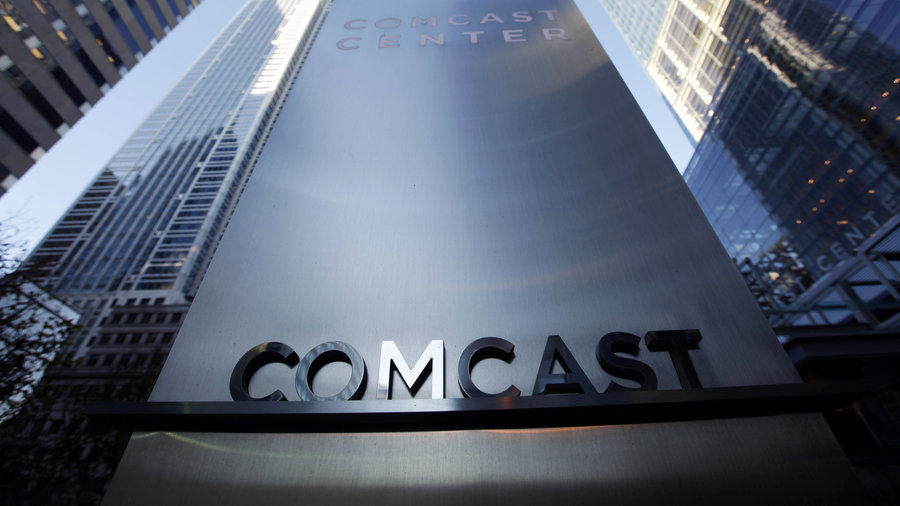
Xfinity Mobile: A little stroke of genius?
Last week US cable giant Comcast launched its long-awaited mobile service dubbing it (not surprisingly) Xfinity Mobile. As expected, the service will rely mostly on Wi-Fi. It’s also a well-strategised move that could bite a sizeable chunk out the US mobile services market.
Last week Comcast finally launched its new Wi-Fi First-style mobile service that relies on Verizon’s 4G network for mobile connectivity and Comcast’s own 16 million Wi-Fi hotspots for the rest.
And the Wi-Fi piece is actually a big deal. ” Up to eighty percent of smartphone data traffic in the U.S. travels over Wi-Fi, not cellular networks, making Wi-Fi a key solution to today’s mobile data consumption,” the press release says.
Comcast’s new service really does look like a well-crafted new venture. First of all, it’s very low CAPEX: Comcast will use its existing Xfinity Wi-Fi hotspot network (which is massive) for most of the traffic, saving enormously on wholesale cellular traffic fees to Verizon. If they get all the details right, Xfinity Mobile users could even climb above the 80% mark for Wi-Fi usage. There’s every incentive for Comcast to push traffic to Wi-Fi where they can.
And the new service is arguably one of the most significant strategic moves ‘from inside the home and out’ for any cableco in the world. For starters, the data packages are priced below those of its mobile competitors. Add to the mix that Comcast is only offering the service to existing Comcast Xfinity subscribers, and in one stroke Xfinity Mobile becomes a lever for both subscriber retention and up-selling. That’s intelligent.
Finally, don’t forget to throw in a sizable new source of revenue. The addressable market for Xfinity Mobile includes anyone with a phone living in any of the about 24 million households that Comcast has wired up for TV & Internet.
And Comcast has more enticing benefits up it’s sleeve: Xfinity Mobile customers will get auto-connect access to loads of Xfinity content including of course live TV, movies, all of that. This means you can bring your home entertainment preferences with you on the road. That alone could sign up a few million subs and lay the groundwork for more to come.
Earlier this year, Comcast launched it’s new & improved digital home platform including an ‘Advanced Gateway’ that (among a slew of other features) acts as a hub for meshed Wi-Fi inside the home. This means that Xfinity customers should get much improved Wi-Fi in and around the house. Better home Wi-Fi is also likely to drive up Wi-Fi usage on the new Xfinity Mobile service. And thus all the pieces of the Comcast wireless strategy fit neatly together.
But as always in business, the devil is in the detail. We still don’t know how Xfinity Mobile will manage (if at all) handoffs between mobile and Wi-Fi connections. This is an important detail for any device that moves out of the home. And Comcast will of course need to deliver hard on all of their ease-of-use promises, including support via native messaging, on-line purchasing & sign-up, etc.
Meanwhile, we keenly await what kind of wireless initiatives that Comcast’s brethren Altice and Charter may come up with perhaps even this year.
/Claus.
The post Comcast’s Xfinity Mobile: A little stroke of genius? appeared first on Wi-Fi NOW APAC.
]]>The post Why mobile will never kill off Wi-Fi appeared first on Wi-Fi NOW APAC.
]]>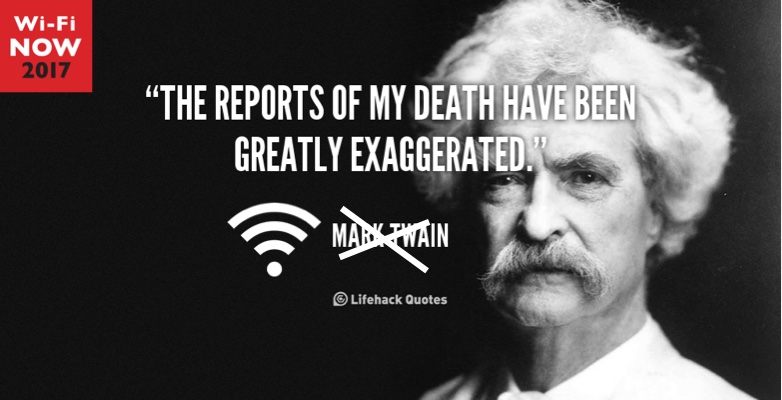
Why mobile will never kill off Wi-Fi
We’ve heard it before: Tech media predicting the end of Wi-Fi. This time the culprit is Bloomberg Technology and a host of syndicated publications. But actually, nothing could be further from the truth.
A couple of weeks ago Bloomberg Technology ran this headline: ‘A World Without Wi-Fi Looks Possible as Unlimited Plans Rise’. The verdict from the analyst community (myself included) was unanimous: Nope, never gonna happen.
It’s actually the reverse: Carriers need Wi-Fi more than ever
The reasons why are so multitudinous that is hard to know where to start. But let’s begin here: Just imagine what would happen if some 60-70% of phone data traffic currently carried on Wi-Fi networks moved to cellular.
Mobile carriers would need to triple capacities. Even if it were possible (there’s probably not enough spectrum to allow this) it would cost billions of dollars. Add to this that current plans are ‘unlimited’ so tripling capacity would produce no additional revenue. It’s a deep red business case.
By the same logic carriers need Wi-Fi more than ever in the age of ‘unlimited’ data plans. Also note that data plans are not truly ‘unlimited’ – instead they throttle down speeds once large data bucket sizes have been exhausted.
Another important point is that on average, Wi-Fi services are substantially faster than average mobile data rates, and that phones will automatically prefer known Wi-Fi networks above cellular – unless users actively delete such networks from device memory.
And despite the advent of ‘unlimited’ plans, the impact on Wi-Fi traffic has been largely unnoticeable. We’ve written about it here. It’s counter-intuitive, but evidence (including from Devicescape here) suggests that additional availability of Wi-Fi bandwidth stimulates demand so that both Wi-Fi and mobile traffic increases.
If you want to read more compelling reasons why mobile 4G or 5G will never kill off Wi-Fi, read this blog by analyst Dean Bubley here.
What about LTE-U?
One reason for renewed interest in killing off Wi-Fi could well be recent announcements – among others by T-Mobile USA – that US mobile carriers will begin deploying 4G in 5 GHz ‘Wi-Fi bands’. We don’t know how extensive such deployments might be, but we’re guessing that they will be fairly localised. From the most cynical point of view, LTE-U is a carrier’s way to get users to pay for services that they would otherwise get for free – with Wi-Fi.
The idea that LTE-U or prospective 5G unlicensed (yes, that’s coming up soon as well) would replace Wi-Fi is absurd. Carriers have no technical or economical way of replacing hundreds of millions of low-cost Wi-Fi networks in homes and businesses – and scores of large enterprise and city Wi-Fi networks are being built every day.
Also don’t forget that hundreds of millions of devices without SIMs still need connectivity.
/Claus.
The post Why mobile will never kill off Wi-Fi appeared first on Wi-Fi NOW APAC.
]]>
